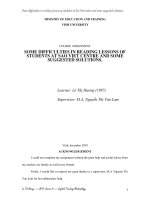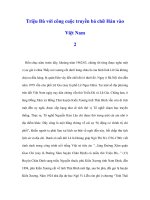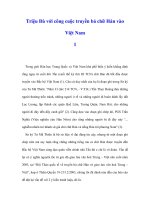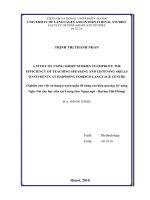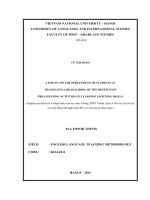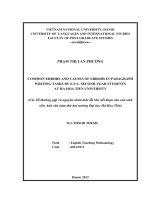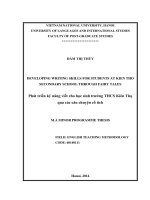- Trang chủ >>
- Đề thi >>
- Đề thi lớp 3
Factors developing Logistics skills of students at Ba Ria-Vung Tau University, Viet Nam
Bạn đang xem bản rút gọn của tài liệu. Xem và tải ngay bản đầy đủ của tài liệu tại đây (157.46 KB, 6 trang )
<span class='text_page_counter'>(1)</span><div class='page_container' data-page=1>
<i>e-ISSN: 2278-487X, p-ISSN: 2319-7668. Volume 22, Issue 2. Ser. II (February. 2020), PP 01-06 </i>
<i>www.iosrjournals.org </i>
<b>Factors developing Logistics skills of students at Ba Ria-Vung </b>
<b>Tau University, Viet Nam </b>
Do Thanh Phong
<i> School of Economics– Laws – Logistics, Ba Ria – Vung Tau University, Viet Nam </i>
<i><b>Abstract: </b>The globalization of trade has demonstrated the importance of logistics in the world economy. </i>
<i>Effective development of logistics services will contribute to increasing the competitiveness of the economy and </i>
<i>the country. In recent years, logistics services have been focused on developing in Vietnam. However, one of the </i>
<i>barriers to the development of logistics in Vietnam is the shortage of vocational skills of human resources </i>
<i>operating in the industry.We conduct research on the qualifications of Logistics students at Ba Ria -Vung Tau </i>
<i>University, Vietnam, resulting from the following factors: Health, Industrial behavior, business Logistics, </i>
<i>communication skills, problem-solving skills impact on Logistics skills. Factors affecting the development of </i>
<i>Logistics skills will help to train Logistics skills of students of Ba Ria - Vung Tau University in order to </i>
<i><b>contribute to the development of logistics services in Ba Ria-Vung Tau Province. </b></i>
<i><b>Key Word: training, satisfaction, logistics, human resources, factors. </b></i>
--- ---
Date of Submission: 21-01-2020 Date of Acceptance: 11-02-2020
--- ---
<b>I. Introduction </b>
Logistics is a commercial activity organized by merchants performing one or more stages including
receiving goods, transportation, warehousing, customs clearance and papers, consulting customers, packaging,
delivery or other services related to goods for remuneration (National Assembly,2015) . The term Logistics has
been mentioned a lot recently, especially in the field of seaports, international transportation, and freight.
Logistics is the management of the flow of goods, information and other resources, including energy
and people, between the point of origin and point of consumption to meet consumer requirements. Logistics
involves information integration, transportation, inventory, warehousing, material handling and packaging
(Wikipedia). Logistics is the process of optimizing the activities of transporting and storing goods from
production to final consumption through a series of economic activities (Van, 2003). Logistics is a series of
continuous activities, closely related to each other, mutual interaction is carried out scientifically and
systematically through research, planning, organization and management steps. , carry out, inspect, control and
perfect activities including jobs related to supply, transportation, production tracking, warehousing, distribution
procedures, customs .... Therefore, logistics is a process that involves many different activities within the same
organization, from developing a strategy to specific and specific activities to implement the strategy (Tuan.
2015). Logistics is the process of planning and coordinating activities to deliver products or services to
customers around the world. Activities related to logistics may include: customer service, transportation,
purchasing, inventory and warehouse management, forecasting, strategic planning, etc. The goal of these
activities is to meet End customer needs. In other words, logistics activities ensure the delivery of the right
product with the right quality, right condition to the right customer at the right place, at the right time at the right
price (seven right in logistics, Van,2006) .
In recent decades, globalization in the economy has made the world an open market. That requires
businesses to promptly meet customer needs, reduce order fulfillment time, maintain quality with reasonable
costs and flexibility to achieve a competitive advantage. And the solution to this is the need for an efficient
logistics system (Ronald,1987) . The importance of logistics can be summarized in several points as follows:
Logistics has a great impact on the national economy and the world: logistics facilitates the exchange
in the market, provides the main labor force and is the main buyer of assets and materials in the background
economy.
Logistics plays a very important role in human existence: the logistics system provides the availability
of food, water, medicine and other materials necessary for human existence continuously.
Logistics has a strong impact on the quality of life: the logistics industry employs workers all over the
world, providing cost-effective ways of distributing goods locally and worldwide. The more affordable the price
of goods, the higher the quality of life.
</div>
<span class='text_page_counter'>(2)</span><div class='page_container' data-page=2>
country. In recent years, logistics services have been focused on developing in Vietnam. However, one of the
barriers to the development of logistics in Vietnam is the shortage of vocational skills of human resources
operating in the industry. The paper provides basic issues as well as trends in logistics skills requirements in the
current period.
Logistics involves many important business activities. Any business that produces or buys and sells
products needs logistics experts to manage the product and information flow within the business, the region and
the world. Service providers such as hospitals, restaurants or hotels also need to manage logistics operations.
Figure 1 is an example of the types of businesses and organizations that a logistics staff can work.
In the study career in Logistics conducted by the Council of Supply Chain Management Professionals
(Mangan and Christopher 2005; Hartnut, 2011) pointed out that there is no single career or career path for
employees. logistics. Besides jobs focused on logistics and supply chain functions such as transportation
management, warehousing, production planning, procurement, information systems, customer service, etc.
Logistics may be affected by the size, type, geographical scope and organizational structure of businesses or
organizations.
Logistics skills of students are career skills after graduation: Information flow management; cargo
flow management; money flow management (Council, 2017). Students 'Logistics skills are defined and
measured in two aspects: (1) Employers' satisfaction with their employees; (2) Satisfying according to the
components of work that employees bring to employers (Harold; Mark and Heinz, 2008). Model of research on
satisfaction (Dale, 1962), working skills focus on factors: Personal qualities expressed through personality,
education, health, loyalty, personality of employees dynamic. To identify models suitable to the conditions in Ba
Ria-Vung Tau Province. The research team investigated students studying Logistics at Ba Ria-Vung Tau
University, Vietnam and identified the following factors:
Component 1- Health : Expressed through endurance at work, labor intensity, height and weight . Including
human health : Expressed through endurance at work, labor intensity, height and weight.
Component 2-Industrial behavior: Level of concentration in work, progressive spirit in work, accountability,
<b>observance of rules, time , care, accuracy in work, cooperation labor room. </b>
Component 3-Business Logistics :Customs, warehouse, freight, Information technology, marketing. Skills in
customs declaration procedures, customs laws, concepts of types of warehouses, goods, and skills to arrange
goods on shelves. skills of making bill of lading for the mode of transportation and use of computer software,
internet and marketing (Logistics,2017)
Component 4-Communication skills: Communication skills, teamwork skills, english skills, information
technology, creative thinking skills. The participants revealed the same factors with the previous review in
literature review including being confident in communication, opening their relationship, improving teamwork
skills, developing creative and more flexible ( Thuan and Han, 2019). Students can study other foreign
languages: French, Japanese, Chinese, Korean, but the second language has more difficult factors than learning
English in Logistics skills (Han,2019).
<b>Component 5- Problem-solving skills: Completed workload, efficiency, achieved work results, unsatisfactory </b>
labor results. Employees with good work results must identify ways to solve problems and work motivation..
<b>II. Material And Methods </b>
With the aim of studying factors affecting the development of vocational skills of Logistics students at
Ba Ria - Vung Tau University, Vietnam. Since then, helping Ba Ria - Vung Tau University train human
resources to meet employers and propose solutions to train Logistics human resources in Ba Ria - Vung Tau
province
<b>Study Design: Prospective open label observational study </b>
<b>Study Location: This is a study at the School of Economics - Law - Logistics, Ba Ria - Vung Tau University, </b>
Viet nam.
<b>Study Duration: October 2019 to December 2019. </b>
<b>Sample size: 200 students. The survey table consists of 25 observed variables so the minimum number of study </b>
elements is: 5 * 25 = 125 ( Hair et al. 2006)
<b>Sample size calculation: The sample size is estimated based on a simple ratio design. The total number of </b>
</div>
<span class='text_page_counter'>(3)</span><div class='page_container' data-page=3>
<b>Subjects & selection method:T he study subjects were drawn from Logistics students at the School of </b>
Economics - Law - Logistics, Ba Ria - Vung Tau University, Vietnam , each group has 50 students
The object of study is as follows:
Group I (n = 50 students istudying in year 1)
Group II (n = 50 students studying in year 2)
Group III (n = 50 students studying in year 3)
Group IV (n = 50 students studying in year 4).
<b>Inclusion criteria: </b>
1.Health (H)
2.Industrial behavior (I)
3.Business Logistics (B)
4.Communication skills (C)
5. Problem-solving skills (P)
<b> 6. Logistics skills (L) </b>
<b>Research questions </b>
<b>Question 1: Health (H): Expressed through endurance at work (H1), labor intensity (H2), height and weight </b>
(H3).
<b>Question 2: Industrial behavior (I): Level of concentration in work (I1), progressive spirit in work (I2), </b>
accountability (I3), observance of rules (I4), time (I5), care(I6),accuracy in work (I7), cooperation labor
<b>room(I8). </b>
<b>Question 3: Business Logistics (B):Customs (B1), warehouse (B2), freight (B3), Information technology(B4), </b>
marketing (B5).
<b>Question 4: Communication skills (C): Communication skills (C1), teamwork skills (C2), english skills (C3), </b>
information technology(C4), creative thinking skills (C5).
<b>Question 5: Problem-solving skills (P): Completed workload (P1), efficiency (P2), achieved work results (P3), </b>
unsatisfactory labor results (P4).
<b>Question 6: Logistics skill (L): Information flow management (L1); cargo flow management (L2); Money flow </b>
management (L3).
<b>Answer: Interview responses using a 5-level Likert scale (Likert R.A., 1932) give the following scores: </b>
1- Absolutely not good;
2- Not good;
3- Average;
4- Good;
5- Very good
The bigger the score, the higher the agreement level
<b>Statistical analysis </b>
We used IBM SPSS (Statistical Package for Social Science) version 20 to calculate the reliability of the
questionnnaires before analyzing the results.
The finding was found that the number of Cronbach Alpha was > 0.7. Moreover, each question in the
survery had the number bigger than 0.7.
Test KMO and Bartlett's Test, 0.5 <KMO <1, discovering factor analysis is suitable for real data.
Regression coefficients to determine the coefficient of the influencing factors Use the Spearman test to
determine the absolute value of standardized residuals.
<i> The level α < 0.05 was considered as the cutoff value or significance. </i>
<b>III. Result </b>
<b>Step 1 Factor analysis </b>
</div>
<span class='text_page_counter'>(4)</span><div class='page_container' data-page=4>
<b>Table no 1 Typical variables and good quality scales </b>
<b>The scale </b> <b>Variable </b> <b>Cronbach Alpha of the scale </b>
H H1, H2,H3 0,905
I I1,I2,I3, I4, I5,
I6, I7, I8 0,931
B B1, B2,B3,B4,B5 0,946
C C1,C2,C3,C4,C5 0,922
P P1,P2,P3,P4 0,935
L L1, L2, L3 0,833
After 3 months of follow upmit was found that table no 1 Shows the scales have the required reliability
because it is greater than 0.7, of which the lowest is the Logistics skill scale of students with α = 0.833, and the
highest is the logistics business scale of students with α = 0.946.
<b>Testing the suitability of EFA </b>
<b>Table no 2 KMO and Bartlett's Test </b>
Kaiser-Meyer-Olkin Measure of Sampling Adequacy. 0,784
Bartlett's Test of Sphericity
Approx. Chi-Square 3.911,643
Df 200
Sig. 0,000
Table no 2 Shows KMO = 0.784, satisfying the condition: 0.5 <KMO <1, discovering factor analysis is suitable
for real data.
The tests for the quality of the scales and the EFA model tests, identify 5 scales representing the factors
affecting students 'Logistics skills and 1 scale representing students' Logistics skills with 28 characteristic
variables
<b>Step 2 Multivariate regression </b>
To identify factors affecting Logistics skills of students studying Logistics at Ba Ria-Vung Tau University,
Vietnam, the overall correlation model has linear regression form L = β0 + β1F1 + β2F2 + β3F3 + β4F4 + β5F5
+ ei. In which: β1, β2…. , βk are the coefficients to be determined using the correlation between students'
Logistics skills and the influencing factors. The variables included in the regression analysis are determined by
scoring the factors
<b>Testing Regression coefficients </b>
Factors affecting Logistics skills of students are important to propose solutions and adjust skills training for
students. The testing results are as follows:
<b>Table no 3 Coefficientsa</b>
Model Unstandardized Coefficients
B T Sig.
(Constan) 0,000 ,000 1,000
F1- H ,155 2,046 ,043
F2- I ,157 2,068 ,041
F3- B ,242 3,191 ,002
F4- C ,156 2,049 ,042
F5- P ,360 4,748 ,000
Table no 3 Shows :
- Health variables (F1), industrial style (F2) and communication skills (F4). <0.05, so industrial wind behavior is
significantly correlated with students' Logistics skills with 95% confidence.
- Business Logistics variable (F3) and problem solving skills (F5) have significant Sig. <0.01, so the Logistics
business variable significantly correlates with the Logistics skills of students with 99% confidence.
From the results of the above table test, we have the regression function of Logistics skills of Logistics major
students at Ba Ria - Vung Tau University, Vietnam:
<b>L (Y) = 0,000 + 0,157 (F1) +0,242 (F2) + 0,360 (F3) + 0,156(F4) + 0,155(F5) </b>
</div>
<span class='text_page_counter'>(5)</span><div class='page_container' data-page=5>
<b>Test the suitability of the model </b>
- Level of explanation of the model: Logistics skills of students studying Logistics at Ba Ria - Vung Tau
University are explained by the factors (health-H, industry style -I, Business Logistics-B, communication skills
- C, problem solving skills-P) Test results on IBM SPSS 20 software are as follows:
<b>Table no 4 Model summary </b>
R R Square Adjusted R Square Change Statistics Sig. F Change Durbi-Watson
0,513a 0,263 0,229 0,000 0,775
Table no 4 Shows the overall correlation coefficient is R = 0.513, which shows that the Logistics skills
relationship of students with other factors tested is relatively close. With 5 factors of verification explained
26.3% (R2 = 0.263) changes in students' Logitics skills. Thus, changes in Logistics skills of students studying
Logistics at Ba Ria - Vung Tau University are explained by independent variables: .Health-H, industry style-I,
Business Logistics-B, communication skills-C, problem solving skills-P.
- Relevance: Analysis of variance with Sig. <0.01, it can be concluded that the given model is consistent with
the actual data. In other words, the independent variables are linearly correlated with the dependent variables
with 99% confidence.
<b>Test of constant residual variance </b>
Use the Spearman test. Determine the absolute value of the standardized balance. We put the ABSRES
variables, and the independent variables have passed meaningful guarantee tests (F1, F2, F3, F4, F5) into
Spearman test, we get Spearman test results of variables F1, F2, F3, F4 and F5 have significance levels (Sig.)
Greater than 0.05. Through the regression model tests, the variables have statistical significance including: F1,
F2, F3, F4 and F5.
<b>Discuss regression results </b>
The non-standardized regression coefficient determines the location of the effects of the independent
variables as follows: Business Logistics variable contributes 33.64%, industrial style change contributes
22.62%, health contributes 14.67%, communication skill variable 14.58%, problem solving skill contributed
14.49%. Thus, the order affecting Logistics skills of students studying Logistics at Ba Ria - Vung Tau
University, Vietnam is business Logistics, industrial behavior, health, communication skills, turn problem
solving skills on.
<b>IV. Discussion </b>
The sample we surveyed is 200 students (Hair et al. 2006) who are studying Logistics at Ba Ria-Vung
Tau University, Vietnam for 3 months (From October 2019 to November 2019). The total number of students
studying Logistics is 500, so the number of samples (N = 200) accounts for 40% of the total number of students
studying Logistics. We divide the survey of students from Year 1 to Year 4 each of our 50 survey groups. Each
student only surveyed 5 groups of criteria (25 observed variables) and 1 scale representing students' Logistics
skills (with 3 observed variables): health-H, industrial behavior -I, Business Logistics -B, communication
skills-C, problem-solving skills-P. For groups health criteria we conduct from 1 to 5 points for each criterion to
evaluate the actual student performance of performance through endurance at work; labor intensity, height
weight. Each evaluation criterion was assigned a job to 200 students by the research team to compare the
evaluation of the score from 1 point to 5 points.
Data were processed by IBM SPSS (Statistical Package for Social Science) version 20 using Cronbach
Alpha test methods, KMO and Bartlett's Test tests, Coefficientsa, and Spearman tests. From the testing methods,
we prove that Logistics skills of students have influences on Logistics business factors, industrial behavior,
health, communication and problem solving skills.
5 groups of factors affecting logistics skills of students of Ba Ria - Vung Tau University, Vietnam, the
group of business logistics factors including customs declaration procedure skills, management practice, and
arrangement warehouse, freight transport by means of transport (road and air transport, sea), Practical skills of
information technology applications in Logistics and Marketing.
<b>V. Conclusion </b>
</div>
<span class='text_page_counter'>(6)</span><div class='page_container' data-page=6>
DOI: 10.9790/487X-2202020106 www.iosrjournals.org 6 | Page
variable contributes 33.64%, industrial style changes. 22.62%, health variables 14.67%, communication skills
14,58%, problem solving skills 14.49%.
<b>References </b>
[1]. Council of Logistics Management (2019), Careers in Logistics, .
[2]. Dale, Y. (1962) Personnel Management and Industrial Relations,Prentice-Hall.
[3]. Han,H.V (2019),Cognitive Factors in Second Language Acquisition: A Study in The English Language Faculty of Ba Ria Vung Tau
University, Viet Nam, IOSR Journal Of Humanities And Social Science (IOSR-JHSS), Vol 24, Issue 6, Ser. 7,pp.01-08.
[4]. Hair, J. F., Black, W. C., Babin, B. J., Anderson, R. E., & Tatham, R. L. (2006). Multivariate data analysis (Vol. 6). Upper Saddle
River, NJ: Pearson Prentice Hall.
[5]. Hartnut Stadtler Christoph Kilger, (2011), Supply chain Managenment and advanced
[6]. Heinz Weihrich, Mark Cannice, Harold Koontz (2008), Management a Global & Entrepreneurial Pe Paperback
[7]. Likert, R. A. (1932). Technique for the Measurement of Attitudes. Archives of Psychology, 22, 1-55
[8]. Logistics Service Business Association, (2017), Logistics Business Handbook, Van Nghe Publishing House
[9]. National Assembly (2015) commercial law, Section 4, article 233
[10]. Mangan, J., Christopher, M.(2005), Management development and the supply chain manager of the future, International Journal of
Logistics Management, 16(2), pp.178-191
[11]. Ronald, H.B (1987), Basic Business Logistics, Prentice- Hall International,Inc
[12]. Thuan, N.N & Han,H.V (2019) The effects of extra-curricular activities on the soft skills development of English major student at
Ba Ria-Vung Tau University, Viet Nam, IOSR Journal Of Humanities And Socience, Vol 24, Issue 6, Ser. 6, 74-80.
[13]. Trong, H. & Ngoc.C. N. M. (2008), Research Data Analysis with SPSS, Hong Duc Publishing House
[14]. Tuan,.N. Q. (2015), State management of Logistics services at Hai Phong Port, Economic Master thesis, Central Institute for
Economic Management.
[15]. Van, D. T. H. (2003) Logistics - Basic issues, Labor - Social Publishing House, Hanoi.
[16]. Van, D. T. H. (2006) Logistics Management, Labor - Social Publishing House, Hanoi.
</div>
<!--links-->
